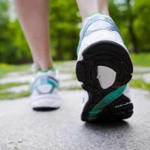Shoes for Women with Osteoarthritis (Most Common Arthritis)
Some accessories that you wear every day may have an effect in helping to control your osteoarthritis (OA). Shoes are one of them. While they can give a good looking on your feet, they may also help reduce strain that hits the joints when you walk, especially for the joints of knees (the most essential weight-bearing joint).
However, if you are a woman with OA, choosing shoes may be not only about good for the disease, but also how to choose one that looks good too. The following is a guideline of important checklists you need to prioritize in finding and buying the best shoes for your osteoarthritis.
 Rubber soles can absorb some strain every time your feet hit the road. This choice is beneficial to provide more cushioning!
Rubber soles can absorb some strain every time your feet hit the road. This choice is beneficial to provide more cushioning!
However not all rubber soles are good. Make sure to choose one that is flexible enough to support your feet, especially at the points that need great flexibility such as at ball of the foot! And don’t forget to check the size!
The definition of shoes with high heels may vary slightly from one expert to another. But in general, heels that are greater than two inches are categorized into high heels.
This kind of footwear is commonly considered bad not only for people with OA but also for everyone due to the possible risks of some problems in short and long term. Even some studies have shown that the use of high heels may increase the risk of foot pain and even knee degeneration.
So, they should be your last option. If you need to use them, make sure to choose one that is not higher than 1.5 inches and come with friendly features (such as a back strap, anatomical arch, or cupped heel) that can help distribute the weight evenly and more stable.
While high heels are bad choice, this doesn’t mean you can buy any shoes as long as they are low heels. Still, be always smart on your selection.
For instance, beware to low heels that come with pointed toe. Because this can increase the risk of cramped toes that can be painful!
Remember that the shape of your shoes can take the shape of your feet. If you use low heels with pointed toe, this can cause another deformities problem such as hammertoes.
Low heels with roomy toe boxes, wedge heels for extra room at heel, and come with rubber soles are commonly more recommended. There are now many low heels without pointed toe (in wide sizes) that also look good and stylish.
Some experts say that the use of clogs can increase strain on the knee. For this reason, it’s much better to avoid any clogs, particularly those with lightweight plastic varieties
These shoes are bad, particularly for arthritis of big toe and arch – and also not recommended if you have swollen or stiff foot joints.
The reason of why these shoes are recommended is due to they can make your feet comfortable as well as when you are going with barefoot. Being barefoot can help make the knee joint work easier when you walking.
The greater strain the hits the knee can be bad for the affected knee joint by osteoarthritis. Flip flops can significantly help reduce the knee load as well as going with shoeless.
If you are ready to start exercise, choosing the right one of athletic shoes is something you need to concern as well – particularly true if you have a plan to choose walking as a part of your exercise program.
- Many shoes come with thick treads. But if you have OA of the knee, it’s recommended to avoid them because may host a tripping hazard.
- High-top sneakers may be your best choice if you have weak ankles.
- Analyze the natural way of your foot rolls inward when you make steps such as walking – a condition called pronation! If you have normal pronation, you can use stability sneakers. But if your steps are under-pronation or over-pronation – neutral sneakers are more recommended and also often prescribed for people with OA.
- And don’t skimp on your choice because quality is so essential!
For some people with OA, the use of boots may be not the best option since they can be heavier in weight than other shoes. But they can be stabilizing choice, especially for those with arthritis on the ankle.
In you think can get benefits with boots, make sure you wear one with the following specifications:



